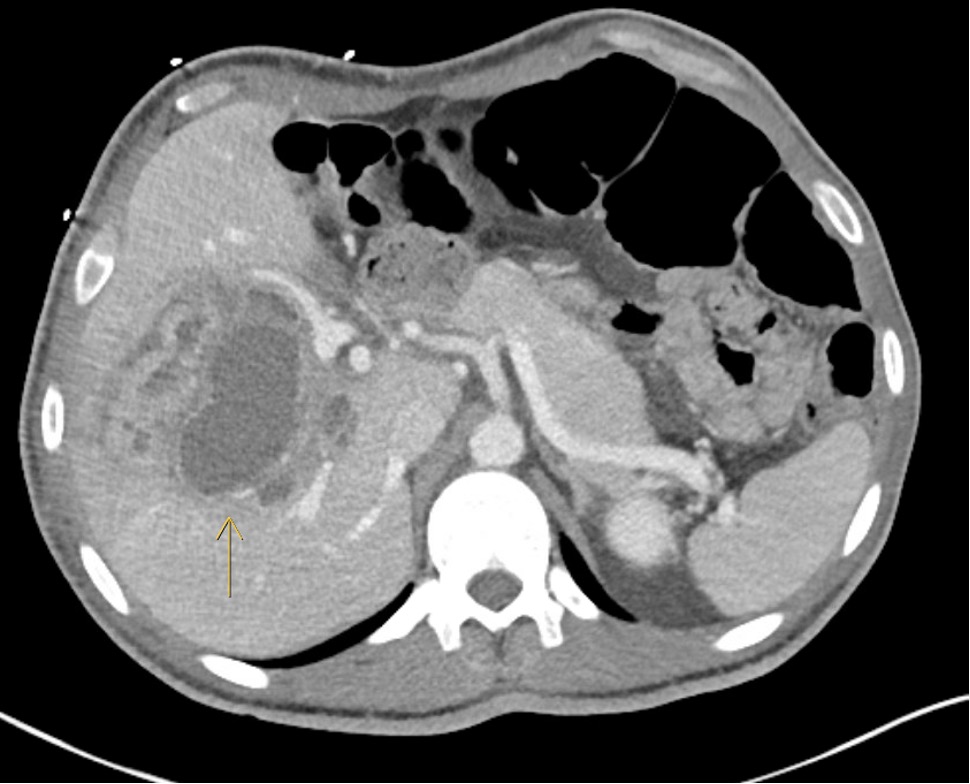Sunday Poster Session
Category: Liver
P1688 - Abscess Denied: Hepatic Abscess in a Young Patient With Diabetic Ketoacidosis
Sunday, October 26, 2025
3:30 PM - 7:00 PM PDT
Location: Exhibit Hall

Theodore Moore, MD
Duke University Health System
Durham, NC
Presenting Author(s)
Theodore Moore, MD1, Daniel Bujnowski, MD1, Kara Wegermann, MD2, Afreen Shariff, MD1, Maria Martinez-Cruz, MD1, Matthew Rubach, MD1, Benjamin Wildman-Tobriner, MD1
1Duke University Health System, Durham, NC; 2Duke University School of Medicine, Durham, NC
Introduction: Pyogenic liver abscess (PLA) is the most common intra-abdominal organ abscess, with increasing global incidence. Poorly controlled diabetes mellitus is a significant risk factor. Most PLA patients present with fever (79–90%), abdominal pain (60–84%), and malaise (89%).1 However, asymptomatic cases are more frequently recognized, particularly among immunocompromised individuals, potentially delaying diagnosis. We describe a patient with diabetic ketoacidosis (DKA) found to have a liver abscess.
Case Description/
Methods: 33-year-old man with uncontrolled type 2 diabetes with hyperglycemia, polydipsia, polyuria, and malaise. He was diagnosed with DKA and treated with intravenous fluids and insulin. He denied fever or abdominal pain. Laboratory studies revealed a hemoglobin A1c of 13.8%, leukocytosis to 14.7 x 109/L, elevated alkaline phosphatase 314 IU/L, and chronic mild hyperbilirubinemia 1.8 mg/dL, with normal transaminases. Abdomen CT with contrast showed a large (8.9 × 8.7 cm), multiloculated cystic lesion in the right hepatic lobe consistent with a liver abscess, along with sigmoid colon thickening. Ultrasound-guided drainage grew Streptococcus viridans, mixed anaerobic gram-positive organisms, Lactobacillus species, and Candida albicans. He was treated with intravenous antibiotics and transitioned to oral fluconazole and amoxicillin/clavulanate for 6 weeks. Repeat imaging after 1 month showed resolution of the liver abscess and persistent rectosigmoid thickening.
Discussion: This case illustrates an atypical presentation of PLA in a young patient with uncontrolled diabetes and DKA, lacking classic features such as fever or abdominal pain. The combination of chronic bilirubin elevation and rectosigmoid inflammation raises concern for underlying inflammatory bowel disease or biliary pathology (e.g., primary sclerosing cholangitis), which may predispose to PLA.1 Because patients can present with nonspecific symptoms and laboratory findings, the presence of predisposing factors can be helpful in increasing the level of diagnostic suspicion to prompt work up. Clinicians should consider PLA in immunocompromised individuals who present with unexplained liver enzyme changes, even without overt signs of infection.
References
1.Mavilia MG, Molina M, Wu GY. The Evolving Nature of Hepatic Abscess: A Review. J Clin Transl Hepatol. 2016;4(2):158–168. doi:10.14218/JCTH.2016.00004

Figure: Computed tomography image of the abdomen with contrast shows a large multiloculated abscess in the right hepatic lobe.
Disclosures:
Theodore Moore indicated no relevant financial relationships.
Daniel Bujnowski indicated no relevant financial relationships.
Kara Wegermann: FocusMed CME – Speaker.
Afreen Shariff indicated no relevant financial relationships.
Maria Martinez-Cruz indicated no relevant financial relationships.
Matthew Rubach indicated no relevant financial relationships.
Benjamin Wildman-Tobriner indicated no relevant financial relationships.
Theodore Moore, MD1, Daniel Bujnowski, MD1, Kara Wegermann, MD2, Afreen Shariff, MD1, Maria Martinez-Cruz, MD1, Matthew Rubach, MD1, Benjamin Wildman-Tobriner, MD1. P1688 - Abscess Denied: Hepatic Abscess in a Young Patient With Diabetic Ketoacidosis, ACG 2025 Annual Scientific Meeting Abstracts. Phoenix, AZ: American College of Gastroenterology.
1Duke University Health System, Durham, NC; 2Duke University School of Medicine, Durham, NC
Introduction: Pyogenic liver abscess (PLA) is the most common intra-abdominal organ abscess, with increasing global incidence. Poorly controlled diabetes mellitus is a significant risk factor. Most PLA patients present with fever (79–90%), abdominal pain (60–84%), and malaise (89%).1 However, asymptomatic cases are more frequently recognized, particularly among immunocompromised individuals, potentially delaying diagnosis. We describe a patient with diabetic ketoacidosis (DKA) found to have a liver abscess.
Case Description/
Methods: 33-year-old man with uncontrolled type 2 diabetes with hyperglycemia, polydipsia, polyuria, and malaise. He was diagnosed with DKA and treated with intravenous fluids and insulin. He denied fever or abdominal pain. Laboratory studies revealed a hemoglobin A1c of 13.8%, leukocytosis to 14.7 x 109/L, elevated alkaline phosphatase 314 IU/L, and chronic mild hyperbilirubinemia 1.8 mg/dL, with normal transaminases. Abdomen CT with contrast showed a large (8.9 × 8.7 cm), multiloculated cystic lesion in the right hepatic lobe consistent with a liver abscess, along with sigmoid colon thickening. Ultrasound-guided drainage grew Streptococcus viridans, mixed anaerobic gram-positive organisms, Lactobacillus species, and Candida albicans. He was treated with intravenous antibiotics and transitioned to oral fluconazole and amoxicillin/clavulanate for 6 weeks. Repeat imaging after 1 month showed resolution of the liver abscess and persistent rectosigmoid thickening.
Discussion: This case illustrates an atypical presentation of PLA in a young patient with uncontrolled diabetes and DKA, lacking classic features such as fever or abdominal pain. The combination of chronic bilirubin elevation and rectosigmoid inflammation raises concern for underlying inflammatory bowel disease or biliary pathology (e.g., primary sclerosing cholangitis), which may predispose to PLA.1 Because patients can present with nonspecific symptoms and laboratory findings, the presence of predisposing factors can be helpful in increasing the level of diagnostic suspicion to prompt work up. Clinicians should consider PLA in immunocompromised individuals who present with unexplained liver enzyme changes, even without overt signs of infection.
References
1.Mavilia MG, Molina M, Wu GY. The Evolving Nature of Hepatic Abscess: A Review. J Clin Transl Hepatol. 2016;4(2):158–168. doi:10.14218/JCTH.2016.00004

Figure: Computed tomography image of the abdomen with contrast shows a large multiloculated abscess in the right hepatic lobe.
Disclosures:
Theodore Moore indicated no relevant financial relationships.
Daniel Bujnowski indicated no relevant financial relationships.
Kara Wegermann: FocusMed CME – Speaker.
Afreen Shariff indicated no relevant financial relationships.
Maria Martinez-Cruz indicated no relevant financial relationships.
Matthew Rubach indicated no relevant financial relationships.
Benjamin Wildman-Tobriner indicated no relevant financial relationships.
Theodore Moore, MD1, Daniel Bujnowski, MD1, Kara Wegermann, MD2, Afreen Shariff, MD1, Maria Martinez-Cruz, MD1, Matthew Rubach, MD1, Benjamin Wildman-Tobriner, MD1. P1688 - Abscess Denied: Hepatic Abscess in a Young Patient With Diabetic Ketoacidosis, ACG 2025 Annual Scientific Meeting Abstracts. Phoenix, AZ: American College of Gastroenterology.
